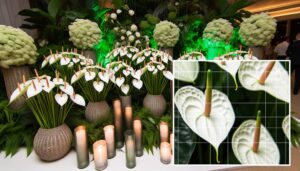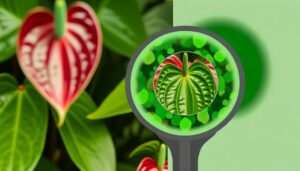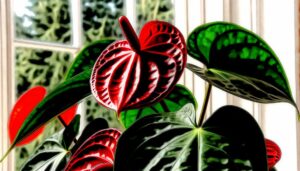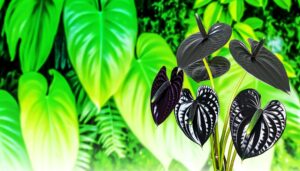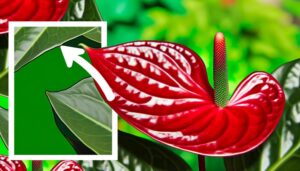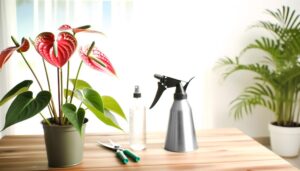How to Grow and Care for Anthurium Fire Red Tropical Flowers
To grow Anthurium Fire Red tropical flowers, use a well-aerated, organic-rich soil mix comprising orchid bark, perlite, and peat moss while maintaining a slight acidic pH of 5.5 to 6.5. Provide bright, indirect sunlight and maintain temperatures between 70-85°F during the day.
Water thoroughly with room-temperature water and keep humidity levels between 60% and 80%. Choose a container slightly larger with proper drainage.
Prune dead leaves during active growth and monitor for pests, utilizing integrated pest management strategies as needed. Regular inspection and proper care techniques are imperative for best growth.
Discover additional detailed techniques for exceptional plant health ahead.
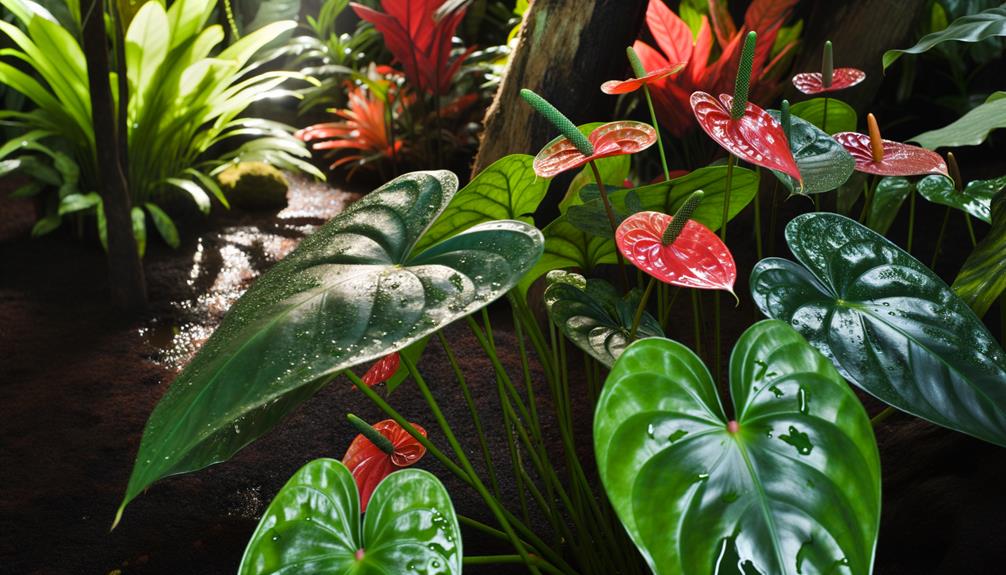
Key Takeaways
- Choose a well-aerated, organic-rich potting mix with orchid bark, perlite, and peat moss.
- Provide bright, indirect sunlight to avoid photodamage and ensure healthy growth.
- Water thoroughly with room-temperature water and maintain high humidity levels between 60% and 80%.
- Keep daytime temperatures between 70-85°F and nighttime temperatures between 60-70°F.
- Regularly prune dead or damaged leaves and inspect for pests and diseases.
Choosing the Right Soil
Selecting the appropriate soil composition is crucial for the best growth and health of Anthurium Fire Red tropical flowers. It requires a well-aerated, organic-rich medium with excellent drainage properties. Ideal soil blends typically consist of a mix of orchid bark, perlite, and peat moss. Orchid bark enhances aeration, preventing root suffocation, while perlite improves drainage, reducing risks of root rot. Peat moss retains essential moisture and nutrients, promoting robust growth.
Incorporating charcoal can further help in detoxifying the soil and maintaining a balanced pH. Ensuring the soil remains loose and free-draining is essential, as overly compact substrates can hinder root development and oxygen uptake, ultimately affecting plant well-being. Regularly monitoring and adjusting soil composition guarantees sustained Anthurium health and vigor.
Light Requirements
Perfect light conditions are necessary for the growth and flowering of Anthurium Fire Red, needing bright, indirect sunlight to replicate their natural tropical habitat. Direct sunlight can cause photodamage, leading to leaf burn and inhibited growth.
For best photosynthesis, place the plant in a spot receiving filtered light, such as near a north or east-facing window shielded by sheer curtains. Alternatively, artificial grow lights with a spectrum of 400-700 nm can be used to supplement natural light, especially in low-light environments.
It is important to monitor light intensity using a light meter, aiming for 10,000 to 20,000 lux. Insufficient light can result in leggy growth and reduced flowering, thus maintaining appropriate light levels is crucial.
Watering Guidelines
Proper watering is essential for maintaining the health and vibrancy of Anthurium Fire Red, requiring a balanced approach to guarantee the soil remains consistently moist but not waterlogged.
It is imperative to use well-draining soil to prevent root rot, which can occur if the plant is overwatered. Water the plant thoroughly, allowing excess water to drain out from the bottom of the pot.
Monitor the top 1-2 inches of soil; once it becomes dry to the touch, it is time to rewater. Utilizing room-temperature water reduces stress on the plant's roots.
Avoid allowing the plant to sit in standing water, as this can lead to anaerobic conditions that are detrimental to root health.
Humidity Needs
Maintaining high humidity levels, ideally between 60% and 80%, is important for the best growth and vibrant appearance of Anthurium Fire Red tropical flowers. These epiphytic plants, native to tropical rainforests, thrive in environments with consistently high moisture content in the air.
Utilizing a humidifier can effectively elevate indoor humidity, while grouping plants together can create a microenvironment with elevated moisture. Misting leaves daily with distilled water also helps to meet the plant's humidity requirements.
Additionally, placing the pot on a tray filled with water and pebbles ensures evaporative humidity. It's essential to monitor humidity levels with a hygrometer to prevent conditions that could lead to fungal infections or suboptimal growth due to insufficient atmospheric moisture.
Temperature Preferences
Anthurium Fire Red flourishes in an ideal temperature range of 70-85°F (21-29°C) during the day and 60-70°F (15-21°C) at night, requiring careful avoidance of temperature extremes that can stress the plant.
Outdoor cultivation should be limited to regions where these conditions are consistently met, while indoor settings must be monitored for stable temperatures.
Implementing temperature regulation strategies is vital to secure robust growth and colorful blooms.
Ideal Temperature Range
For perfect growth, Anthurium Fire Red tropical flowers require a temperature range between 70°F and 85°F, with minimal fluctuations. Maintaining this stable thermal environment is essential for best photosynthesis and metabolic functions.
Indoor cultivation should focus on consistent ambient temperatures, utilizing thermostats and humidifiers as needed. These temperature conditions mimic their native tropical habitats, promoting vigorous growth and vibrant blooms.
Sudden temperature changes can stress the plant, leading to reduced flowering and potential physiological disorders. As such, growers should monitor ambient conditions closely, making sure that the temperature remains within this ideal range.
Proper temperature management not only supports healthy foliage but also enhances the plant's overall resilience and longevity. This careful approach guarantees that the Anthurium's ornamental value is fully realized.
Avoiding Temperature Extremes
To maximize growth and prevent physiological stress, it is crucial to avoid exposing Anthurium Fire Red tropical flowers to extreme temperatures outside the recommended range of 70°F to 85°F. Deviations from this prime range can result in stunted growth, chlorosis, and diminished flowering.
Specifically, prolonged exposure to temperatures below 60°F can cause cold stress, while temperatures above 90°F may induce heat stress, leading to cellular damage and impaired metabolic functions.
Consider the following guidance to maintain stable temperatures:
- Monitor ambient temperature: Utilize a reliable thermometer to ensure constant monitoring.
- Implement shading techniques: Use shade cloths to mitigate excessive heat exposure.
- Utilize heating pads: In colder environments, employ heating pads to maintain adequate warmth.
Indoor Vs Outdoor Settings
When deciding between indoor or outdoor settings for cultivating Anthurium Fire Red tropical flowers, it is vital to assess the microclimates each environment offers to maintain ideal temperature ranges.
Indoors, temperatures should consistently range between 70-85°F (21-29°C) to replicate their native tropical habitat. This controlled environment prevents exposure to harmful temperature fluctuations.
Conversely, outdoor cultivation necessitates a climate with similar temperature stability, ideally USDA hardiness zones 10-11. Protect plants from direct sunlight, which can cause thermal stress, and ensure ambient humidity remains high. Employing hygrometers and thermostats can aid in precise monitoring and adjustment.
Whether indoors or outdoors, maintaining these specific parameters is crucial for optimal growth and vibrant blooms of the Anthurium Fire Red.
Fertilizing Tips
Applying a balanced, water-soluble fertilizer every 6-8 weeks is crucial for maintaining the vibrant color and robust growth of Anthurium Fire Red tropical flowers. To optimize nutrient uptake and promote healthy development, the fertilizer should contain equal parts nitrogen (N), phosphorus (P), and potassium (K).
Dilution: Dilute the fertilizer to half the recommended strength to prevent root burn and nutrient overload.
Application Timing: Fertilize during the plant's active growth period, typically from spring to early fall.
Soil Moisture: Ensure the soil is damp before application to enhance nutrient absorption and minimize root damage.
Regular fertilization fosters vigorous growth and prolonged blooming, contributing to the overall healthiness of Anthurium Fire Red plants.
Repotting Instructions
To maximize growth and health of Anthurium Fire Red tropical flowers, repotting is essential when roots become crowded. Begin by selecting a new container that is 1-2 inches larger in diameter than the current pot, ensuring adequate drainage.
Prepare a well-aerated potting mix consisting of equal parts orchid bark, perlite, and peat moss, then carefully transplant the anthurium, positioning it at the same soil depth as before.
Choosing New Container
Choosing a suitable container for repotting Anthurium Fire Red necessitates careful evaluation of size, material, and drainage capabilities to guarantee perfect growth and health. The container should be slightly larger than the current pot to accommodate root expansion without causing waterlogging. Choose materials like terracotta or plastic, ensuring they provide structural integrity and breathability. Adequate drainage is crucial to prevent root rot; hence, the container must have multiple drainage holes.
Key considerations include:
- Size: A container 1-2 inches larger in diameter than the previous pot is ideal.
- Material: Terracotta offers breathability, while plastic retains moisture.
- Drainage: Multiple holes at the base to facilitate efficient water egress.
These elements collectively foster an excellent environment for Anthurium Fire Red.
Preparing Potting Mix
Guaranteeing ideal growth for Anthurium Fire Red requires a meticulously prepared potting mix that provides the necessary balance of aeration, moisture retention, and nutrient availability.
Start with a base of high-quality, well-draining orchid potting medium to ensure peak root aeration. Incorporate peat moss or coir to enhance moisture retention, while maintaining the mix loose and airy. Adding perlite or pumice will improve drainage and prevent root rot.
Integrate a controlled-release fertilizer containing essential macro and micronutrients to support sustained growth. Maintain a slightly acidic pH level, ideally between 5.5 and 6.5, to facilitate nutrient uptake.
Thoroughly blend these components to create a homogeneous mixture before potting your Anthurium Fire Red.
Transplanting the Anthurium
Repotting an Anthurium Fire Red requires careful handling to avoid damaging the delicate root system while securing ideal conditions for continued growth. Begin by selecting a pot that is one size larger than the current container, guaranteeing proper drainage.
Gently remove the plant from its existing pot, taking care to loosen the roots without causing harm. Position the Anthurium in the new pot and surround it with a well-aerated, organic-rich potting mix.
*Key steps to follow include:*
- Confirm the new pot has drainage holes to prevent waterlogging.
- Water the plant thoroughly after repotting to settle the soil.
- Place the repotted Anthurium in a location with indirect, bright light to reduce transplant shock.
These steps will promote a healthy shift and robust growth.
Pruning Techniques
Proper trimming methods for Anthurium Fire Red tropical flowers involve the precise elimination of dead or damaged leaves to maintain plant health and promote robust flowering. Utilize sterilized trimming shears to make clean, angled cuts close to the base, minimizing tissue damage and infection risk.
Regularly inspect the plant for senescent leaves or inflorescences, removing them promptly to prevent resource diversion from healthy growth. Additionally, thin out overcrowded areas to enhance air circulation, reducing fungal pathogen susceptibility.
Trim during active growth phases, typically in the spring and summer, to ensure prime recovery and vigor. These meticulous practices not only sustain the aesthetic appeal but also enhance the plant's overall strength and blooming potential.
Pest Control
Implementing effective pest management techniques is important for maintaining the health and vitality of Anthurium Fire Red tropical flowers. Regular monitoring and early detection are vital to prevent infestations.
Utilize integrated pest management (IPM) approaches that are environmentally sustainable and effective.
- Biological Control: Introduce beneficial insects such as ladybugs and predatory mites to naturally reduce pest populations.
- Cultural Practices: Maintain proper sanitation by removing debris and dead plant material, reducing habitats for pests.
- Chemical Treatments: Apply insecticidal soaps or neem oil judiciously, targeting specific pests like aphids, mealybugs, and spider mites.
Adopting these strategies will help protect your Anthurium Fire Red from common pests, promoting strong growth and vibrant blooms.
Disease Prevention
To prevent diseases in Anthurium Fire Red tropical flowers, it is crucial to implement rigorous sanitation practices and maintain ideal growing conditions. Regularly sterilize pruning tools to avoid pathogen transmission. Maintain optimal air circulation and humidity levels to prevent fungal infections. Avoid waterlogging by using well-draining soil and watering appropriately. Monitor plants for early signs of disease such as leaf spots or wilting, and act promptly by isolating affected plants and using suitable fungicides.
| Disease | Symptom |
|---|---|
| Root Rot | Wilting, Yellowing |
| Bacterial Blight | Leaf Spots, Browning |
| Anthracnose | Dark Lesions |
| Powdery Mildew | White Residue |
| Fusarium Wilt | Stem Rot, Wilting |
These preventative measures will help your Anthurium Fire Red plants remain healthy and vibrant.
Propagation Methods
Propagation of Anthurium Fire Red tropical flowers can be effectively achieved through techniques such as division, stem cuttings, and seed sowing. Each method requires specific conditions to guarantee successful growth.
Division involves separating mature clumps during repotting. It is crucial to make sure each section has roots and foliage.
Stem cuttings demand the selection of healthy stems. These stems should be treated with rooting hormone and placed in a well-draining medium to encourage root development.
Seed sowing, though less common due to its complexity, demands fresh seeds sown in a sterile medium. It is important to maintain high humidity and warmth for successful germination.
Conclusion
In summation, cultivating Anthurium fire red tropical flowers requires meticulous attention to soil makeup, light exposure, watering, moisture levels, and temperature regulation.
Trimming, pest control, and disease prevention are essential to maintain plant health, while propagation methods promote long-term viability.
By following these guidelines, one can establish a setting where these flowers can thrive, similar to a finely tuned orchestra playing in harmony.
Proficiency in these methods will result in lively, flourishing Anthurium specimens, displaying their stunning beauty.

